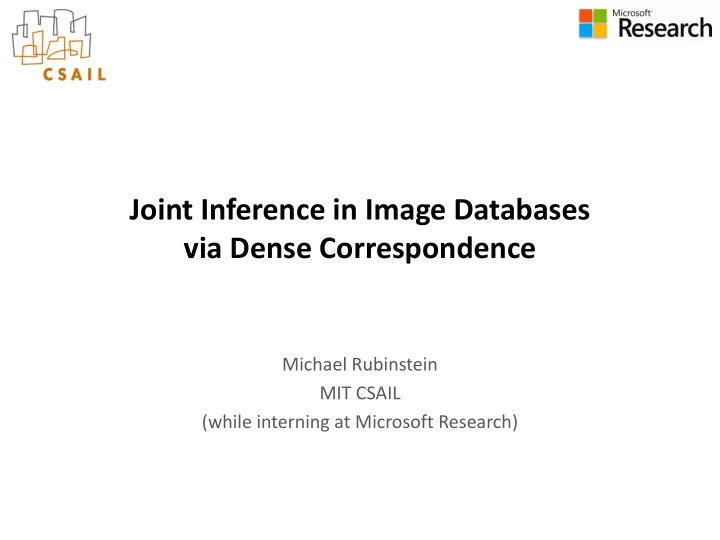

Joint Inference in Image Databases via Dense Correspondence Michael Rubinstein MIT CSAIL (while interning at Microsoft Research)
My work • Throughout the year (and my PhD thesis): Temporal Video Analysis and Visualization Source Source Pulse signal amplified Breathing motions amplified • This short talk: my work during the summers (MSR 2011, 2012) – Inference in large, weakly-annotated image databases
Videos vs. Image Datasets • Goal: we want to infer properties of pixels/regions – Semantics, layers, geometry (depth), motion, … • Recent advances allow us to treat a set of images like videos ! – Correspondence between adjacent frames in videos : optical flow, layer models, tracking, … – Correspondence between similar images in databases : Feature Matching, graph matching, Spatial Pyramid Matching (SPM), SIFT flow, …
Image C orrespondence is Challenging… Query Best match Multiple objects; no global transform Changing perspective, occlusions Intra-class variation Background clutter
y …but Good Solutions Exist x SIFT Flow [Liu et al. TPAMI 2011] Query Best match
Correspondence-driven Approaches to Computer Vision Annotation of Label Warp to Ground truth Query Best match best match best match transfer Liu et al. TPAMI’11 Warped candidates and depths Query Inferred depth + Karsch et al. ECCV’12
How to densely label new images? Annotated database (class, depth, motion, …) Image correspondence + information transfer Query image Image + transferred info
Big Visual Data Pixel labels usually unavailable! Photo collections Internet
How to densely label new images? Annotated database (class, depth, motion, …) Image correspondence + information transfer Query image Image + transferred info Image correspondence + joint inference Database +propagated info Unannotated (partially annotated) database
Joint Inference for Image Databases • Weakly supervised Annotation Propagation in Large Image Databases via sky Dense Image Correspondence (ECCV 2012) mountain With Ce Liu, William T. Freeman sea rock • Unsupervised Unsupervised Joint Object Discovery and Segmentation in Internet Images (CVPR 2013) With Ce Liu, Armand Joulin, Johannes Kopf
Annotation Propagation Input: A large database of images where only some are tagged and very few (possibly none) are densely labeled tree, sky, river mountain sky, mountain sidewalk, road, car building, tree, sky tree sky, river building, bridge
Annotation Propagation Output: The same database with all the pixels labeled and all the images tagged tree, sky, river tree, sky, plant mountain, field, tree, sky, road mountain grass car, building building, sky, tree sky, mountain tree, sky, sidewalk sidewalk, road, car tree, sky, car building, tree, sky building tree road, car, building sky, river tree, staircase, sky tree, sky, river sky, building building, bridge road, plant, door person, mountain tree sidewalk, car, building
Dense pixel/region labeling is important • Enhanced image search • Constructing training sets for detectors/classifiers PASCAL 2012 • Image editing – User edit propagation HaCohen et al. 2013
Pixel-wise image graph 𝑄 (word | 𝐽(𝒒) ) – using machine learning
Inference Results Input image + Intra-image reg. + Inter-image reg. MAP appearance Input image local evidence Neighbors Dense corr. Neighbors warped Neighbors local evidence warped
Optimization Appearance Modeling Propagation • Coordinate descent, iterating between estimating the appearance model (learning) and tag propagation (inference) • Lots of engineering, but nothing revolutionary – Partition message passing into intra- and inter-image updates – Intra-image message passing on separate cores – Parallel inter-image message passing
From stronger local evidence to weaker local evidence Input image Local evidence + intra-image reg. + Inter-image reg. neighbors warp
Results on SUN Dataset Textual tags available for only half the images in database No detectors (e.g. sky detector, person detector, …) No prior knowledge on labels, their locations, etc. SUN dataset [Xiao et al. 2010] - 9556 images, 522 labels
Joint Inference for Image Databases • Weakly supervised Annotation Propagation in Large Image Databases via sky Dense Image Correspondence (ECCV 2012) mountain With Ce Liu, William T. Freeman sea rock • Unsupervised Unsupervised Joint Object Discovery and Segmentation in Internet Images (CVPR 2013) With Ce Liu, Armand Joulin, Johannes Kopf
Object discovery and Co-segmentation • Input : A set of images containing some “common object” • Output : Every pixel in the dataset marked as belonging or not belonging to the “common object” • No additional information on the images or the object class
Object discovery and Co-segmentation “Car” Image search Object discovery and segmentation Our automatic segmentation results Images downloaded from the Internet State of the art co-segmentation [Joulin et al. CVPR 2012]
Benchmark “plane” Dataset (MSRC)
Real- world “plane” Dataset (Internet Search)
Image Graph Image graph
Basic Idea • Pixels (features) belonging to the common object should be: 1. Salient - Dissimilar to other pixels (features) in their image Captured by image saliency measures 2. Sparse - Similar to other pixels (features) in other images (with respect to smooth transformations) Captured by (dense) image correspondence
One of these things is not like the others Source Saliency Warped neighbor Matching Score Segmentation
One of these things is not like the others Source Saliency Warped neighbor Matching Score Segmentation
One of these things is not like the others Horse Face
Car (4,347 images, 11% noise)
Horse (6,381 images, 7% noise)
Airplane (4,542 images, 18% noise)
Conclusion • Labels in big visual data are often unavailable/noisy • Dense image correspondence (SIFT flow, and others) useful to capture structure, resolve visual ambiguity – Becoming a mature technology • Joint inference for weakly-labeled image databases tree, sky, river tree, sky, road tree, sky, plant mountain, field, mountain car, building grass building, sky, tree – Annotation Propagation: partial tags + very few sky, mountain tree, sky, sidewalk sidewalk, road, car tree, sky, car tree road, car, building building, tree, sky building (possibly none) pixel labels tree, staircase, sky tree, sky, river sky, river sky, building building, bridge road, plant, door person, mountain tree sidewalk, car, building – Object discovery and segmentation: only assuming some underlying “common object”
Thank you! Michael Rubinstein MIT CSAIL
Recommend
More recommend